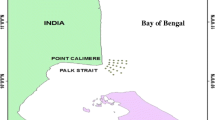Abstract
An investigation of water transparency characteristics and light attenuation by waters of a turbid subtropical impoundment showed that allochthonous inputs of silt during summer floods, impoundment morphometry, and the warm monomictic thermal cycle were the main factors regulating the temporal and spatial variations in water transparency. Statistically significant relationships between the Secchi disc transparency, turbidity of the surface water, mean diffuse attenuation coefficient and beam attenuation coefficient, were established. These relationships allowed for an approximation of the 1 per cent of surface light intensity depth to be made by using any of the four parameters. The attenuation of blue light was greater than that of red light, owing to the effects of suspended clay particles on the spectral attenuation of light.
Similar content being viewed by others
References
Allen, S. E. 1974. Chemical analysis of ecological materials. Blackwell, London.
Austin, R. W. 1973. Problems in measuring turbidity as a water quality parameter. Environmental Protection Agency Seminar on Methodology for Monitoring the Marine Environment, Seattle, Washington, 16–18 October.
Biswas, S. 1977. Thermal stability and phytoplankton in Volta Lake, Ghana. Hydrobiologia, 56: 195–198.
Burt, W. V. 1956. A light-scattering diagram. J. Mar. Res. 15: 76–80.
Clarke, G. L. & James, H. R. 1939. Laboratory analysis of the selective adsorption of light by seawater. J. Opt. Soc. Am. 29: 43–55.
Grobbelaar, J. U. & Stegmann, P. 1976. Biological assessment of the euphotic zone in a turbid man-made lake. Hydrobiologia. 48: 263–266.
Hergenrader, G. L. & Hammer, M. J. 1973. Eutrophication of small reservoirs in the Great Plains. In: Man-made lakes: Their problems and environmental effects, Ackermann, W. C., White, G. F. and Worthington, E. B. (eds). American Geophysical Union, Washington, D.C., pp. 560–566.
Holmes, R. W. 1970. The Secchi disk in turbid coastal waters. Limnol. Oceanogr. 15: 688–694.
Jerlov, N. G. & Kullenberg, B. 1953. The Tyndall effect on uniform minerogenic suspensions. Tellus, 5: 306–307.
Jerlov, N. G. 1976. Marine optics. Second edition, Elsevier, Amsterdam.
Kirk, J. T. O. 1977. Attenuation of light in natural waters. Aust. J. Mar. Freshwater Res. 28: 497–508.
Mitchell, D. S. & Marshall, B. E. 1974. Hydrobiological observations on three Rhodesian reservoirs. Freshwater Biol. 4: 61–72.
Nie, N. H., Hall, C. H., Jenkins, J. G., Steinbrenner, K. & Bent, D. H. 1975. Statistical package for the social sciences. Second edition, McGraw Hill, New York.
Ruttner, F. 1954. Fundamentals of limnology. University of Toronto Press.
Stegmann, P. 1975. Preliminary physico-chemical and primary productivity studies of the Hendrik Verwoerd Dam. M.Sc Thesis, University of the Orange Free State, Bloemfontein.
Tallin, J. F. 1960. Self-shading in natural populations of a planktonic diatom. Welt. Leben 12: 235–242.
Talling, F. J. 1971. The underwater light climate as a controlling factor in the production ecology of freshwater phytoplankton Mitt. int. Verein. theor. angew. 19: 214–243.
Talling, J. F. & Driver, D. 1963. Some problems in the estimation of chlorophyll a in phytoplankton. Proceedings, Conference on Primary Productivity Measurement, Marine and Freshwater, Hawaii, 1961. US Atomic Energy Commission, TID 7633, pp. 142–146.
Tyler, J. 1968. The Secchi disc. Limnol. Oceanogr. 13: 1–6.
Van der Piepen, H. 1978. Report on the NPRL participation on Nimbus G prelaunch sea truth experiments. Special report FIS 169, National Physical Research Laboratory, CSIR, Pretoria.
Vollenweider, R. A. 1971. A manual on methods for measuring primary productivity in aquatic environments. I.B.P. Handbook No. 12, Second edition, Blackwell, London.
Walmsley, R. D. 1978. Factors governing turbidity in a South African reservoir. Verh. int. Ver. Limnol. 20: 1684–1689.
Walmsley, R. D., Toerien, D. F. & Steijn, D. J. 1978. An introduction to the limnology of Roodeplaat Dam. J. Limnol. Soc. Sth. Afr. 4 (1): 35–52.
Author information
Authors and Affiliations
Rights and permissions
About this article
Cite this article
Walmsley, R.D., Butty, M., van der Piepen, H. et al. Light penetration and the interrelationships between optical parameters in a turbid subtropical impoundment. Hydrobiologia 70, 145–157 (1980). https://doi.org/10.1007/BF00015500
Received:
Issue Date:
DOI: https://doi.org/10.1007/BF00015500




